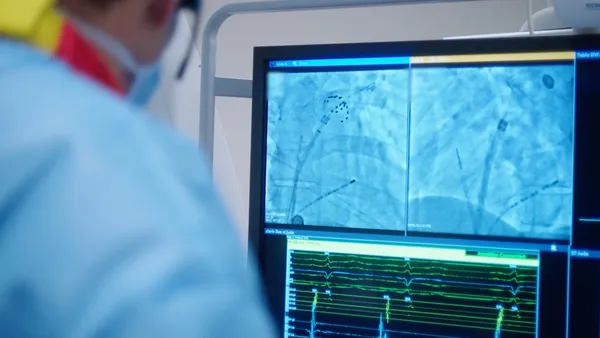Dive Brief:
- Medtronic said 95% of patients who received its HeartWare HVAD heart pump in a less-invasive thoracotomy procedure were free from disabling stroke two years after getting the implant, according to study data shared by the company Monday.
- The new clinical results could help reverse market share losses to Abbott, which makes a competing left ventricular assist device (LVAD) for heart failure patients.
- Medtronic said the Lateral study showed adverse events were more likely to occur during the first 30 days after implant. There were significant declines in bleeding (1.53 vs. 0.51 events per patient year), arrhythmias (3.22 vs. 0.26) and strokes (0.51 vs. 0.12) from 30 to 180 days after the procedure. Data published earlier from the Lateral study showed an 87% survival rate at two years, the company said.
Dive Insight:
The mechanical HeartWare implant helps the left ventricle pump blood in patients with advanced heart failure. It can be used as a bridge to transplant until a donor heart becomes available or as a destination therapy for patients whose condition has not been effectively managed with other treatments.
Rival Abbott has taken market share from Medtronic since last year, when it released study data demonstrating lower stroke rates for its competing HeartMate 3 LVAD and gained FDA approval to market the device as a destination therapy. Weak LVAD sales have been a drag on Medtronic’s cardiac and vascular group results.
The medtech giant is now fighting back with new data of its own on the device. On the company’s earnings call in May, Executive Vice President Michael Coyle talked up the HeartWare HVAD’s smaller size, allowing for the thoracotomy implant approach with lower complication rates. The company in April also released a separate analysis that showed blood pressure management helped reduce stroke rates in patients who received the device as a destination therapy.
The HeartWare system is approved in the United States and Europe for implant via thoracotomy or median sternotomy. In a thoracotomy, a lateral incision is made between the ribs on the left side of the chest to insert the pump, and a second incision is made to attach the outflow graft. The traditional median sternotomy approach involves a vertical incision down the middle of the chest to divide the breastbone.
Medtronic also said Monday it plans to launch a global registry to collect more clinical evidence on survival, adverse events, and economic benefits of the HVAD system when implanted via a lateral thoracotomy in bridge-to-transplant and destination therapy patients.
Medtronic entered the LVAD market in 2016 through the $1.1 billion acquisition of HeartWare, whereas Abbott gained its HeartMate technology through the acquisition of St. Jude Medical in 2017, following St. Jude’s purchase of LVAD maker Thoratec in 2015.
The Lateral clinical trial results were presented at the recent American Society for Artificial Internal Organs conference in San Francisco.










